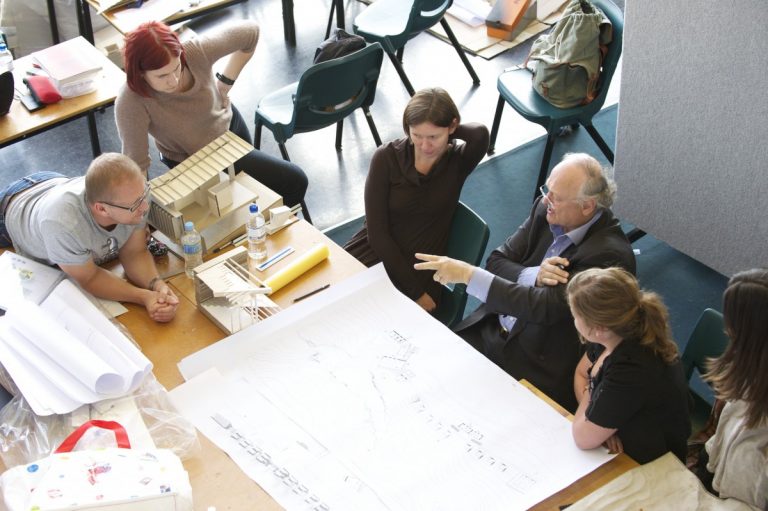
“Whatever good things we build end up building us.” – Jim Rohn
Where are you sat, right now, as you’re reading this? Perhaps on a train, a bus, or if you’re really lucky, amidst the electric buzz of the airport waiting room, about to take flight into the exotic unknown. Maybe you’re at work, surfing the Web from the comfort of your desk, dreaming of an educated life far beyond the workplace walls.
Now just take a moment to really think about your current location. Reach outside the limits of the room in which you’re sat; consider the village, town or city; soak up its complex network of infrastructure, bright green spaces and vibrant community hubs. It’s amazing, right? Now ask yourself – who is responsible for this? Because one thing we can say for sure is that the structure of our man-made world is something we too often take for granted.
In a world that’s constantly changing and developing, we’ve recognised the importance of advocating a more sustainable way of life; not just in terms of things like energy and agriculture, but also in the layout and construction of our towns and settlements. According to figures from Harvard Business Review, the number of people living in the world’s cities will double over the next three decades, swelling from the 3.6 billion recorded in 2011 to more than six billion by 2050, calling for a global surge in sustainable innovation and design.
“Design is more meaningful today than it has ever been,” Irena Škoda – noted eco-building developer – writes for Škoda Design and Architecture, PLLC.
“It will continue to be even more meaningful as we connect the sciences to design and even biomimicry,” she adds. “With the growing technologies of sustainability [in] our fast and changing internet connected world, we need to make what we do last.
“Can you see yourself living in a sustainably designed beautiful space and environment? One that allows you to function at your best? One that gives you peace, tranquillity, enjoyment every time you step into that living space? One that starts with your vision, your belief and your action?” she asks.
“Your vision for that ideal living world will speak of you when people enter it,” she concludes. “And through that space you actually contribute to a greater good because you are net zero or net positive because you live in a sustainable home or building.”
As the United Nations states, all designs from now on must meet “the economic needs of the present without compromising the ability of the planet to provide for the needs of future generations”. And it is, ultimately, highly-skilled global graduates coming from our top Architectural Design-focused Schools who will meet our sustainable demands.
Here are 5 global leaders of Built Environment education…
UNSW BUILT ENVIRONMENT, UNIVERSITY OF NEW SOUTH WALES – AUSTRALIA
UNSW Built Environment shapes our future cities – cities that are resilient, healthy, smart, liveable and inclusive.
Focusing on design issues of every scale – from industrial designed products and services, to building design and construction, through to policy and planning at the urban and territorial levels – UNSW Built Environment investigates environmental challenges like urban heat and urban health, as well as the socio-economic inequity borne out of the spatial divide of our cities.

UNSW Built Environment explores these problems through multiple lenses, including high-performing built environments that are sustainable and resilient, anticipating our future ecological needs; and a human-centred design ethos that responds both to the needs of the individual and society at large.
UNSW Sydney strives to be a global leader in high-impact research that is vital to our landscape’s built environments and inhabitants. Here, researchers tackle diverse and pressing urban issues underpinned by higher-level research programs, including practice-based PhDs, cross-faculty and international research collaborations, as well as industry partnerships and consultations.
Programs at UNSW Built Environment offer breadth and depth, providing disciplinary rigour through interdisciplinary education, cross-faculty initiatives, internships, online courses, dual awards, real-world projects and international programs; allowing students to shape their own paths and prepare for their global career.
UNSW Sydney maintains an agile platform for research, education and exchange, responding to the everchanging needs of the professions while also anticipating the unknown. Above all else, UNSW Built Environment develops skilled and enquiring graduates instilled with an ethical conscience, all of whom can positively engage, adapt and shape our future cities for the benefit of our people and planet.
DEPARTMENT OF ARCHITECTURE, NATIONAL UNIVERSITY OF SINGAPORE (NUS) – SINGAPORE
The Department of Architecture at NUS offers a curriculum that’s world-renowned, representing the only Singaporean School to be accredited by The Royal Institute of British Architects (RIBA), The Board of Architects (BOA) Singapore and The Singapore Institute of Architects (SIA).
NUS Architecture students can choose from a diverse spread of creative avenues that cater to their unique design talents and research interests: architecture, landscape, urban design, urban planning and architectural studies. Through a new initiative called “Architecture Plus”, students are able to blend study options to help them unleash their full potential.
Aiming to deliver a broad-based education for the global citizen and designer, NUS Architecture training and research is rich and comprehensive, with students being taught to think critically and creatively as they hone their unique theories and ideas.

Social and service opportunities are endorsed at NUS, with students’ design experiences amplified by practical partnerships with fellow students and members of faculty. Students also have access to an array of digital prototyping, fabrication and representation technologies, driving efficiency and competence among all participants.
Here, teaching merges abstract theory with concrete practice to encourage students to refine their own ideas. Believing all thinkers and designers must seek inclusiveness in their projects, NUS seeks to support ethical sustainability and environmental responsibility on a global basis.
MANCHESTER SCHOOL OF ARCHITECTURE – UK
Established as a collaboration between the University of Manchester and Manchester Metropolitan University, Manchester School of Architecture (MSA) flawlessly combines two world-class institutions dedicated to the study of the world’s Built Environments. Boasting more than 100-years of academic excellence, the institution has come to represent the UK’s largest and most influential specialised Architecture Schools.
Here, students gain access to the facilities and resources of both universities, including libraries, computer suites, making and media workshops, and of course staff who are experts in their respective fields.
Frequently ranked among the UK’s top architecture Schools, MSA offers students a range of professionally-recognised undergraduate and postgraduate degrees. The principles of variety, vitality and quality underpins study at MSA – a fact that’s echoed in its glowing reviews from various professional bodies, including the Architects Registration Board (ARB) and the Royal Institute for British Architects (RIBA).
The school covers a wide range of disciplines, from urban design, to urban development, ecological and landscape design, and the conservation and management of historic environments. The recently-established Manchester Architecture Research Centre (MARC) houses a variety of interdisciplinary research interests, presenting students with opportunities to collaborate with other departments at both universities.
As a city, Manchester is steeped in architectural history with an abundance of arts venues, galleries, museums and theatres, including the Cornerhouse, The Royal Exchange and the Palace Theatre.
SOUTHERN CALIFORNIA INSTITUTE OF ARCHITECTURE (SCI-ARC) – USA
Founded in 1972 by a group of faculty and students from the Department of Architecture at Cal Poly Pomona, SCI-Arc represents the ideal destination for budding architects who dream of rebuilding our future. Keen to approach the architecture discipline through an innovative, speculative, and experimental lens, Sci-ARC currently functions as one of the few independent architectural institutes in the US.

Nestled in a quarter-mile long former freight depot in the Arts District of Los Angeles, Sci-ARC serves as a unique hub for inspiring and supporting the next generation of architects. LA itself has a long-held heritage of design exploration, and SCI-Arc uses this to feed enthusiasm so students whole-heartedly believe they can construct new responses to the changing needs and aspirations of contemporary life.
Students here are led by professional (or practicing) architects in a dynamic learning setting, and are constantly urged to break through borders of assumption to create, explore and test the boundaries of architecture.
SCI-Arc provides a rigorous undergraduate, graduate and postgraduate program portfolio. The undergraduate program embodies both the discipline and practice of architecture, offering design excellence and intellectual breadth through a liberal arts-based curriculum. The school’s graduate catalog also promotes a spirit of thought and inquiry, responding to shifts in society, technology and culture, as well as how the field can inspire a new wave of thought worldwide.
Studying abroad through exchange initiatives is a popular feature of student life at SCI-Arc. Here, participants can experience the architecture and culture of countries around the world, with recent partnerships seeing SCI-Arc students travel to Mexico, China, Japan and Colombia to complete parts of their studies.
DEPARTMENT OF ARCHITECTURE, ETH ZURICH – SWITZERLAND
“The Department of Architecture D-ARCH at ETH Zurich offers a holistic architectural education that understands design and construction as a reflection of constant transformation,” says Hubert Klumpner, Dean of the Department of Architecture at ETH Zurich. “Thanks to an outstanding environment, we are able not only to provide solutions to the challenges of our age, but to implement these in the physical world.”
ETH Architecture aims to test the processes, materials, constructions, historical and theoretical deliberations of the building design discipline, constantly reshaping the framework in which Architecture is created.

The far-reaching skillset of ETH Zurich means students gain a genuine multi-disciplinary research experience. Strategies employed across the social sciences, humanities, engineering, material and spatial sciences are put to use by the Engineering Department, instilling students with a well-rounded understanding of the subject.
There is a tiered study model at ETH, with Bachelor’s and Master’s degrees as well as Doctorate and Continuing Education programs. The Bachelor’s in Architecture lasts three years, while the Master’s course is two years and should be supplemented with an additional six-month internship period.
The outstanding teaching and research infrastructure at D-ARCH is among the best in the world, including the gta Archives, the Werner Oechslin Library, and the Material Collection as well the state-of-the-art laboratories, workshops and studios in which architecture is experienced.
*Some of the institutions featured in this article are commercial partners of Study International
Liked this? Then you’ll love these…
Leading Schools of Architecture in the UK and Ireland
Shape the world through a degree in architecture and design







